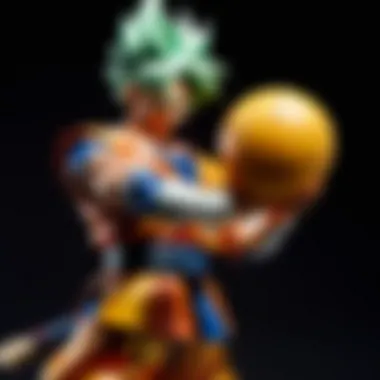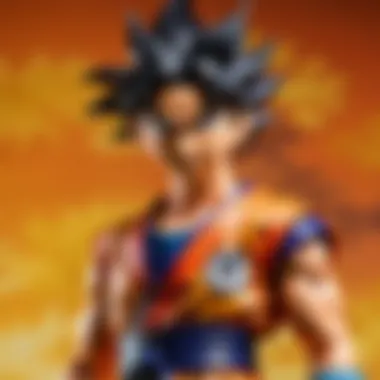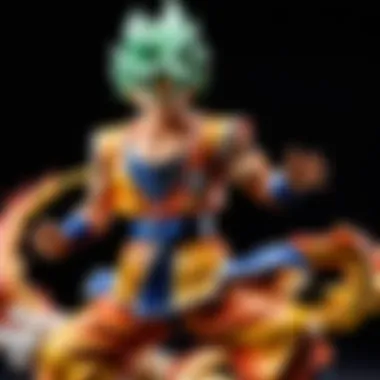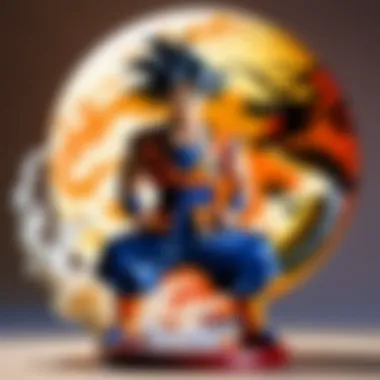Exploring Shodo in Dragon Ball: Art and Culture Unveiled


Intro
The concept of shodo plays a significant role in Japanese culture and art, particularly within the context of the anime phenomenon like Dragon Ball. Shodo, or
Prelude to Shodo
The concept of shodo, or Japanese calligraphy, goes beyond mere letters and aesthetics. This art form symbolizes the union of form and expressive spirit. In the context of this article, understanding shodo is essential because it serves as a cultural pillar at the intersection of art, tradition, and modernity. Shodo enriches the dynamic narrative of radar franchises like Dragon Ball. By exploring this intersection, readers can appreciate not only the depth of the anime but also its ties to Japanese culture.
Definition and Historical Background
Shodo refers to the art of brush writing. Its origins can be traced back to ancient China, and it was introduced to Japan over a thousand years ago. The Japanese adapted the technique, bonding it with their own characters and styles. The evolution of shodo reflects broader cultural shifts. Initially used for formal rituals and documents, it turned into an artistic endeavor. Just as martial arts grew both as a means of defense and as an art, shodo embodies both function and expression. Over centuries, many notable artists have shaped its forms and techniques, adding layers to what we consider shodo today.
Cultural Significance in Japan
In Japan, shodo is greatly valued as more than art; it becomes a visible language that communicates emotions and thoughts. The practice requires not only technical skills but also an understanding of rhythm and fluidity. This grace represents the underlying essence of Japanese culture: harmony, balance, and respect.
In spiritual terms, shodo serves as a form of meditation. Slow, deliberate brush strokes encourage mindfulness. The act of writing transforms into a serene experience where the calligrapher channels internal energies. Collectively, this cultural important has persisted across generations, leaving an indelible mark on society. Shodo projects Japanese value: dedication and discipline, and these principles resonate within various facets of the Dragon Ball narrative.
Overview of Dragon Ball
The analysis of Dragon Ball is central to understanding the interaction between cultural art forms and popular media. This section focuses on the variables that shaped the franchise, offering insights into how traditional and contemporary elements combine in art, storytelling, and character design. Studying Dragon Ball offers clarity on its evolution and role in influencing global culture, particularly in its integration of shodo as an artistic expression.
Creation and Evolution
Dragon Ball was created by Akira Toriyama, first published as a manga in 1984. It became a cornerstone of shonen anime and manga due to its engaging storytelling and rich character development. The narrative draws elements not just from Japanese culture, but also influences from expressive art forms like shodo. Toriyama’s approach involves simplicity in line work and exaggerated features which draw on shodo calligraphy principles, reflecting clarity and intention in art.
Over the decades, Dragon Ball adapted through various modifications in art style and plot, leading to distinct arcs in the series: Dragon Ball, Dragon Ball Z, and others. These transformations reveal an evolution shaped by fan contributions and cultural contexts. The legacy continues to require artists and writers to respect traditional crafts while innovating new expressions. Thus, understanding the design framework rooted in shodo enhances a deeper insight into the intricate aesthetic modifications seen in characters, settings and overall visual presentation.
Influence on Global Pop Culture
Dragon Ball's impact does not end with its artistic expression; it resonates through a global landscape of comics, video games, toys, and merchandise. The franchise proliferated across borders, establishing significant part of fandom communities both in Japan and international markets. Key features speak to its enduring popularity.
- Engaging Storylines: Iconic arcs propel tales of victory and resilience, obligations stemming from classic Japanese narratives blended with modern themes.
- Character Identification: Fans relate to characters like Goku and Vegeta due to their unique personalities and growth arcs, providing a multi-layered experience.
- Cultural Merger: Elements of shodo art can now be observed, influencing fan art, merchandise, and animation techniques for a diverse audience. This has fostered an engaged global following opening dialogue within pop culture discussions.
Impact assessment show that merchandise not only fuels the economy but celebrates cross-cultural artistic exchanges. Knowing how shodo contributes to Dragon Ball's aesthetics highlights its significant place in portraying narratives explored through animated storytelling.
These interactions and emotional connections must be understood to appreciate the valuable blend of artistry, story, and character development prevalent in Dragon Ball, creating dynamics that pave future pathways for anime and manga forms worldwide.
The Intersection of Shodo and Dragon Ball
The connection between shodo and Dragon Ball extends far beyond surface-level impressions. It lies at the heart of how characters are expressed and how stories are conveyed within the franchise. The integration of traditional Japanese calligraphy creates a unique fusion of visual art and narrative technique. This relationship is important because it shapes the viewers' perception of both the characters and their journeys, translating cultural and artistic significance into storytelling.


Artistic forms like shodo enhance the emotional depth of the series and solidify its roots in Japanese culture. They create a dialogue within the anime that preserves cultural identity. Inspecting this intersection offers insights into how traditional aesthetics still hold relevance in modern storytelling practices. One can observe how shodo influences merchandise too, offering collectors something visually enriching and culturally significant.
Artistic Elements in Character Designs
Shodo plays a notable role in the character designs of Dragon Ball. The flowing brushstrokes can evoke different traits and personalities in the characters. Take Goku, for instance. His design is sharp yet fluid, which mirrors his energetic disposition. On the opposite side, Vegeta, with a more aggressive form, might have angular lines that signify his fierce character. Little details in their designs, influenced by shodo, accentuate their behaviors and guide audience interpretation.
The details in clothing or tattoos often feature kanji that represent attributes like bravery or peace, which tie directly back to shodo’s history. Those visual clues provided by shodo emphasize values integral to Japanese society and increasingly elevate the developed narrative.
- Goku's kanji on his gi represents
Shodo as a Collector’s Component
The influence of shodo as a collector's element in relation to Dragon Ball cannot be overstated. The merge of this traditional Japanese art form with contemporary anime opens doors for passionate collectors. Each piece holds not just aesthetic value but also carries rich cultural significance and artistic depth. Enthusiasts seek not only to acquire physical items but also the stories behind each piece of art.
Collecting shodo art associated with Dragon Ball is of particular relevance for several reasons:
- Cultural giants: Dragon Ball stands as a giant in global pop culture. Integrating shodo within its thematic brackets celebrates Japanese heritage.
- Artistic depth: Collectors appreciate the skills involved in shodo. Characters depicted through calligraphy offer a different perspective on familiar attributes.
- Potential value: Unique and limited-edition pieces often reflect a merging of modern trends with historical art, making them valuable collectors’ items.
The intertwining of old and new artistic styles results in collections that offer not just visual pleasure, but also stories and legacies.
Merchandise Featuring Shodo Art
In today's market, merchandise featuring shodo art often represents a fusion of popular culture with traditional skill. Revered franchises like Dragon Ball have capitalized on this trend. Several items stand out:
- Posters and prints showcasing characters written in shodo style.
- T-shirts and apparel incorporating calligraphy elements.
- Specialized collectibles such as figurines inscribed with kanji symbols.
Shodo art found in merchandise caters to varying tastes. Some items offer pop-art vibrancy, while others concentrate solely on the elegant strokes of calligraphy. What this fusion provides to collectors is a tangible connection to the essence of Japan's historical artistry.
Additionally, limited-run or collaboration items tend to elevate their status in collector interest. The cross-cultural dialogue established by bringing shodo to merchandise deepens not only the connection to the Dragon Ball franchise but also emphasizes the artistry involved. Collectors are not just acquiring items; they ennoble traditional culture through this endeavor.
Fan Art and Community Contributions
Fan art that includes shodo is genuinely fascinating. It boldly stands as homeowners’ expressions in capturing Dragon Ball’s allure through individual touches. Communities thrive entirely based on contributions from talented artists. These may include:
- Crafted paintings and illustrations that fuse characters with shodo characters. Artists infuse their personal observation. This ultimately becomes showcases of creativity.
- Posters circulated on social media platforms like Reddit, encouraging shared appreciation for fusing shodo stylings and modern characterizations.
- Twitch streams and online forums exchanging skill tips† and artist techniques, enhancing the global fabric of dragon ball fandom.
Every piece crafted within the fan community constitutes both homage and adaptation of traditional styles. Conversations stemming from discussions about techniques and techniques utilized build communal bonds. Emphasizing these contributions enriches the Dragon Ball experience for all involved. It reflects collective passion from an engaged audience rotating around a common theme.
Understanding the significance of shodo in the Dragon Ball realm proves pertinent for collectors and support networks alike.
Analyzing Key Characters Through Shodo


Shodo, or Japanese calligraphy, serves as a method to portray deeper meanings within the characters of Dragon Ball. This article section will elucidate how shodo not only defines the artistic outline of these characters but also complements their storytelling. Utilizing visually striking elements like brushstrokes and ink patterns, shodo enriches character design and captures emotional and philosophical themes. Notably, the nuanced application of shodo invites both collectors and fans to decipher greater significance in popular personas. Here, we focus closely on Goku and Vegeta, who represent contrasting ideals in the narrative.
Goku and His Symbolism
Goku embodies an array of symbolic themes, from peace to perseverance. His character arc reflects an unyielding spirit, paralleling core tenets of shodo that emphasize flow, motion, and balance. The way ink is applied in shodo often evokes ideas around growth and struggle, mirroring Goku’s journey from a novice fighter to a global savior.
- Fluidity in brushwork parallels Goku’s adaptability throughout the series.
- Strength of lines can visually interpret his determination in battles.
Characteristically, Goku’s kaio-ken and transformations visually connect with shodo's finishing strokes, implying both climax and tactical improvisation. Fans can often discern Goku's evolving notions through how shodo influences his depictions, thus recognizing why several pieces of merchandise feature shodo designs that highlight him.
“The beauty of calligraphy lies not only in the ink on paper but in the story behind each stroke.”
Vegeta and the Ideals of Strength
Vegeta represents the ideals of strength that are often depicted in amplified chiaroscuro contrasts within shodo. His journey, from an antagonist to an anti-hero, lends itself to an array of emotional depth that condenses through the fine lines and bold ink marks within shodo art representations.
- Bold brushstrokes echo Vegeta’s fierce demeanor and unrelenting ambition.
- Sharp contrasts can be seen to reflect the battles he's encountered, both external and internal.
Vegeta's character offers a study in the duality of strength—he embodies rage intertwined with resilience. This dynamic performance translates remarkably well into the tenets of shodo, allowing viewers to engage with both the character’s narratives and the calligraphic representations. When aspects of his personality are explored through shodo, fans find both dramatic depth and artistic beauty shown in works that commemorate his essence, helping to inspire an entire fan culture focused on artistic interpretations.
Considered collectively, the presence of shodo in Goku and Vegeta’s designs provides a layered understanding of Dragon Ball’s rich tapestry. Character examination through the lens of shodo not only deepens appreciation but also entertains various interpretations, creating lasting engaging experiences for enthusiasts and collectors with admiration for intricate cultural reflections.
Shodo in Dragon Ball’s Narrative Structure
Shodo, the art of Japanese calligraphy, plays a pivotal role in enhancing the narratives within the Dragon Ball series. Its presence is not merely decorative but serves to deepen the thematic layers of this iconic anime. By integrating calligraphy, the creators of Dragon Ball evoke broader cultural narratives while shaping the characters and story arcs in unique ways.
Visual Storytelling Techniques
Visual storytelling in Dragon Ball transcends the typical elements of animation. Shodo provides a visual language that expresses character emotions and thematic elements vividly. For instance, when characters release energy attacks or engage in battle, the accompanying calligraphy often appears in dynamic forms, amplifying the action.
Key benefits of incorporating shodo into visual storytelling include:
- Enhanced emotional impact: The flowing brush strokes can convey intensity, tension, or eeriness, capturing viewers' emotions efficiently.
- Cultural resonance: This art form roots the content in Japanese aesthetics, creating an authentic feel for both domestic and international audiences.
- Symbolism: Characters are often associated with specific kanji that reflect their values or powers, providing layers of meaning that resonate with viewers familiar with the language and culture.
In examining specific instances throughout the series, one can note how Goku’s signature move, the Kamehameha, utilises calligraphy to create a direct connection with the character’s spirit and perseverance. The opposing energy moves of adversaries also employ shodo for dramatic flair, illustrating how battle forms and calligraphy fuse to tell dynamic stories.
Cultural References and Their Purpose
Cultural references within Dragon Ball often function to situate the characters in a broader narrative. Shodo as a symbol not only decorates the existing structures but also weighs in on the traditional roles of masculinity, conflict, and identity. References to historical and mythical figures through kanji can hint at parallels between those characters and the faces of Dragon Ball.
The purpose of these cultural references is multifaceted:


- Artistic heritage: They link modern anime with centuries-old traditions, showcasing the evolution of cultural narratives.
- Character development: Understanding characters through their associated kanji provides depth. Vegeta’s kanji, for example, signifies “pride,” underlining his journey throughout the series.
- Engagement: Fans with knowledge of shodo and the related symbols find themselves more invested in the story, recognizing the thematic choices that inform character decisions. This adds an extra layer of engagement as they piece together connections between art and narrative.
The Role of Shodo in Fan Culture
The role of shodo within fan culture, particularly in relation to Dragon Ball, emerges as a compelling topic. It reflects a deeper connection between the anime series and traditional art forms. Fans, artists, and collectors frequently navigate this intersection, allowing for an engaging practice that fosters community interaction and appreciation for both shodo and the Dragon Ball phenomenon.
Cosplay and Art Practices
Incorporating shodo into cosplay and art practices highlights how the culture surrounding Dragon Ball diversifies and enriches itself. Costumes featuring symbols and characters often adapt elements of calligraphy. This generates a multi-layered experience for participants adapting traditional art into contemporary expressions.
Often, cosplayers choose to merge shodo with character representation. For instance, Goku’s trademark Kamehameha can be visually enhanced with kanji on scrolls or garments, adding authenticity to the portrayal. The use of calligraphy in cosplay varies widely, spanning from wellbeing philosophies to visual storytelling aspects. Fans feel empowered as they adopt practices combining character aesthetics with traditional art techniques.
This practice encourages creators and fans to reach a deeper level of understanding of both shodo and the Dragon Ball universe, as calligraphic styles can reflect the personality of the character, thus adding profound meaning. Moreover, platforms like Reddit and Tumblr serve as venues for showcasing such blended talents, prompting discussions on technical skills and emotional expressions tied to their fan art.
Events and Community Gatherings
Events crafted around anime often manifest as gatherings providing opportunities to connect over shared interests in both Dragon Ball and shodo. Conventions themed on anime see the emergence of workshops focused on calligraphy, where artists instruct participants on basic techniques. Such participatory experiences allow fans to elevate their appreciation for shodo, transforming abstract cultural ideals into tangible, practical skills.
Additionally, competitions held at events celebrate artistic interpretations of Dragon Ball. Artists sometimes utilize calligraphic elements in their submissions, merging character illustrations with shodo's visual expressions. This encourages a unique atmosphere where the narratives fostered by shodo coexist with the dynamic presentations of artistic talent.
Opportunities such as workshops in the context of events empower fans and deepen the understanding of shodo discipline. The merging of character narrative with regional aesthetic could form an essential base for future creative expressions.
Ultimately, shodo provides a rich layer to fan culture within Dragon Ball. By embracing traditional art forms, fans navigate a path that fosters deeper engagement with the series, promoting unity and increased appreciation for this rich, multifaceted aspect of Japanese culture.
End: The Lasting Impact of Shodo in Dragon Ball
Shodo, the traditional Japanese calligraphy, serves as a bridge between ancient art forms and modern animation. Exploring the lasting impact of shodo in the Dragon Ball universe reveals not only its aesthetic relevance but also its deeper cultural significance. Embracing shodo within such a widely appreciated franchise provides a unique lens through which one can analyze and appreciate both art forms.
The integration of shodo in Dragon Ball elevates the visual narrative and character representations in the anime. The fluidity and precision of brush strokes convey emotions and symbolize broader themes. For instance, the way Goku’s name is presented can influence audience perception and provide insight into his character development.
Reflections on Cultural Integration
Cultural integration is fundamental in traditional artistic expressions, including shodo. The Dragon Ball franchise successfully intertwines these eccentric characters with the timeless elements of shodo. This both respects and invigorates Japanese art while promoting wider global engagement.
- dragon ball fans often appreciate how calligraphy gives firms characters more context.
- The brushwork draws on the principles of Zen Buddhism, where simplicity leads to a profound understanding. This aspect matters in Dragon Ball as it reflects Goku's relentless pursuit of self-improvement.
Adapting shodo has also led to educational opportunities for fans who want to enhance their knowledge of this traditional art. Workshops and tutorials increasingly incorporate this medium as fans encounte dragons in art forms like cosplay.
Future Trends in Anime Merchandise
As the interest in shodo within the anime realm continues to grow, several future trends can be expected. The demand for merchandise that features traditional styles is likely to rise. Minimalist designs echoing calligraphic techniques are emerging trends that cater to a discerning audience.
Upcoming products may include:
- Limited edition canvas prints
- Art books featuring character designs paired with shodo
- Figure unleashings with shodo-inspired packaging
Moreover, shodo-themed events and exhibitions may become more commonplace within fan conventions. By using social media platforms, such as Facebook and Reddit, the community can collaborate globally on celebrating this artistic integration. Anime merchandise not only deepens fans’ emotional connection with the franchise but also keeps traditional arts alive amidst cultural stimulation.



